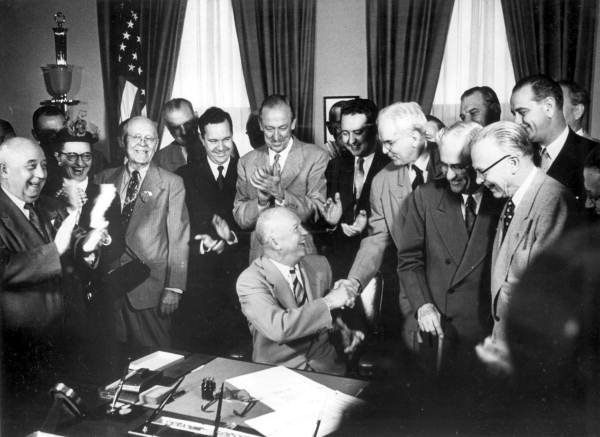
The postwar period was a time defined by unparalleled prosperity. Next the 2nd Planet War, returning GI’s came residence to a booming financial system, housing advancement projects, and help systems like the GI Invoice that expanded and cemented America’s middle course. By 1950 most factories, which include auto producers, experienced created the changeover from wartime production to a purchaser-primarily based economic system, so a great deal so that, in that yr alone, 8 million automobiles were being developed, by 1958 extra than 67 million autos would be created and registered in the United States. Nonetheless, at the begin of the 10 years, most of America’s obsolete roadways had been in no problem to help a large inflow of targeted visitors. Pressure for development of transcontinental superhighways had been increasing due to the fact the late 1930s, nevertheless, conflict involving urban passions and rural passions vying for precedence and a lack of funding left early assignments these types of as the 1944 Federal-Aid Freeway Act lifeless in the h2o. By the 1950’s, in get to handle an inflow of new auto entrepreneurs president Dwight D. Eisenhower publicly supported an interstate freeway development method and on June 29, 1956, he signed the Freeway Profits Act also acknowledged as the National Interstate and Protection Highways Act into law. The act marked the greatest American public functions method of that time authorizing the design of 41,000 miles of interstate highways fitted with overpasses and restricted-entry belt lines. Eisenhower experienced been intensely affected by his experiences in 1919 as a participant in the U.S. Military's first Transcontinental Motor Convoy throughout the United States and his observations of the German audubon highway network during Environment War II. Getting regarded the importance of mobility and efficiency, Eisenhower proposed an American interstate freeway system in his State of the Union address in 1954, which he framed as a countrywide protection application. In an hard work to motivate a cooperative alliance in between point out and federal officers, retired Basic Lucius D. Clay, an engineer and a long-time advisor to the president, proposed a approach in which the federal authorities would shell out 90 per cent of the value of expressway development the funding for which would come from an enhanced gasoline tax (now 3 cents a gallon). Interstate cash were being to then be dispersed in the ratio of each individual state's approximated cost of finishing the process. The initially undertaking beneath the Act was the Mark Twain Expressway (Interstate 70) in St. Charles County, Missouri.
The highways had been meant to eliminate website traffic congestion swap “undesirable slum regions with pristine ribbons of concrete” as a single freeway advocate place it make coastline-to-coastline transportation far more productive and make it quick to evacuate huge towns in case of an atomic attack. When transformative, the Highway Earnings Act also mirrored an enduring legacy of Jim Crow era discriminatory policies and systemic racism. Minimal-price mortgages via the G.I. Monthly bill (which was not supplied to black GI’s), enabled white households to abandon internal towns in favor of suburban housing as properly as prevent ethnic minorities from undertaking the similar. Federal planners of the interstate highway system routed some highways immediately, and frequently purposefully, through predominantly black and brown neighborhoods to predominantly white suburban neighborhoods. Even though the Highway Income Act was at first met with prevalent community help, as far more people today turned displaced and situations in cities deteriorated, activists started to brazenly oppose the program, some likely as far as forcing building stoppages through the late 1950s and early 60s. For the duration of the 1960s, civil rights activists and environmentalists throughout the place in New York City, Baltimore, Washington, D.C. New Orleans and other metropolitan areas managed to avoid roadbuilders from dividing and subjugating their neighborhoods, eventually on the other hand, most of the 41,000 miles of interstate have been done.
Sources:
https://www.senate.gov/artandhistory/background/moment/Federal_Freeway_Act.htm#:~:text=On%20June%2026%2C%201956%2C%20the,Eisenhower%20signed%20it%20into%20legislation.
https://www.npr.org/2021/04/07/984784455/a-temporary-historical past-of-how-racism-shaped-interstate-highways
https://www.theatlantic.com/business/archive/2016/03/function-of-highways-in-american-poverty/474282/
https://highways.dot.gov/community-streets/summer months-1996/federal-aid-highway-act-1956-generating-interstate-procedure
